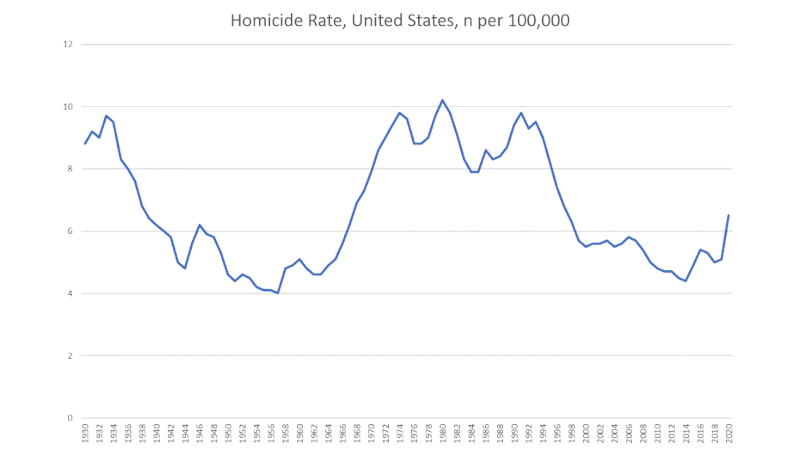Homicide Rates In 2020 Surged To 24-Year High: Another Sign Of Failing Regime – OpEd
By MISES
By Ryan McMaken*
By mid 2020, it was already becoming clear that the United States was experiencing a spike in crime. Indeed, by midyear, numerous media outlets were already reporting remarkably large increases in homicide in a number of cities. It was clear that if then current trends continued, homicide rates in the United States would reach levels not seen in over a decade.
With full-year data for 2020 now available on the FBI’s Crime in the United States report, we can see that those predictions were right. According to the report, the homicide rate in the United States rose to 6.5 per 100,000 in 2020, which is the highest rate reported since 1997—a twenty-four-year high.
Moreover the increase from 2019 to 2020 was one of the largest increases the US has experienced in ninety years. For similar increases in a similarly short period of time, we must go back to the 1960s—or even the 1940s. In other words, this is not normal. If the current trend continues, the US could find itself back experiencing homicide growth not experienced since the late 1960s and early 1970s.
It remains to be seen, however, if this is a temporary spike or part of a longer trend. If it is a spike, we can expect homicide rates to fall back to around 5 per 100,000, as had become a common experience over the past decade. If it is just a spike, then we can blame the surge in homicide on short-term events such as the covid lockdowns or the Black Lives Matter riots. If the surge is part of a larger trend, however, we’ll need to look to more broad and permanent causes for a satisfactory explanation.
But finding the causes of larger trends in homicide rates is no simple matter, and ideological groups tend to use movements in homicide rates as “proof” of the correctness of their preferred political hobby horses.
There is compelling evidence, however, that trends in crime are driven largely by how the public views the legitimacy of the regime and its institutions. In short, the theory rests on the idea that crime increases when a jurisdiction’s residents do not respect government institutions and do not believe that government institutions can provide safety or administer justice in a fairly reliable way.
If the United States is indeed at the beginning of an upward trend in homicide, it might be more evidence of what many already suspect is happening: trust in American political institutions is falling, and consequently fear of private crime and social disorder is rising.
Homicides: Some Historical Perspective
In order to get some perspective on these trends, however, we have to look at historical movements in homicide rates.
There is significant disagreement over the measurement of homicide rates in the early twentieth century, and data is especially spotty before the FBI established the Uniform Crime Report system in 1930. There is much more consensus, however, that homicide rates were high by today’s standards during the early 1930s. These rates began to decline rapidly after 1934, and this began a long downward trend in homicide that lasted until the late 1950s. This trend bottomed out at 4 per 100,000 in 1957. By 1965, homicide rates had begun a rapid ascent, climbing from 4.6 per 100,000 in 1963 and peaking at 9.8 per 100,000 in 1980. Homicide rates remained at elevated levels throughout the 1980s, but went into steep decline after 1993, reaching 4.4 per 100,000—a fifty-one-year low—in 2014.

Since 2014, however, the homicide rate has increased by more than 45 percent. Yet, 2020’s rate of 6.5 per 100,00 is not especially high by twentieth-century standards, and we’re not yet returning to the bad old days of the 1970s and 1980s, when violent crime was high year after year.
On the other hand, the magnitude of 2020’s increase is sizable and alarming. Measured as a percentage increase, 2020’s increase is simply the largest ever recorded.
Homicides in terms of raw totals increased by a whopping 29 percent from 2019 to 2020. No other one-year percentage change in ninety years has been as large. Certainly, in some years the total number of homicides has increased by very large amounts. For example, during the early 1970s, the US experienced some immense increases in terms of totals.
Yet the only comparable percentage increases can be found over two-year periods in the past. For example, from 1944 to 1946, homicides increased rapidly as young men flooded America’s cities and towns following the end of the Second World War. Homicides had been suppressed throughout the war by the fact most of the nation’s young men—the people most likely to commit violent crime—had been shipped off to war. Homicides increased 34 percent, from 6,553 in 1944 to 8,784 in 1946. That was a very temporary situation, however, and the “trend” ended in 1946. By contrast, from 1966 to 1968, total homicides increased by 26 percent, rising from 11,606 in 1966 to 14,686 in 1968. This was only the beginning of an upward and severe trend in homicide that would last for years.
What Causes These Changes?
There are many different theories that purport to explain trends in homicides. Many people naturally gravitate toward the ones that confirm their existing world views. For example, some groups can be counted on to blame racial discrimination or a lack of government welfare as the causes of crime. Some say its economic inequality. Others might turn to racial theories to claim that certain ethnic groups are always behind surging homicide. And of course, a favorite alleged cause of changing homicide rates is the presence of firearms.
Like everyone else, I have my own preferred theory and it’s this: trends in homicide are driven largely by the public’s views of the legitimacy of the state’s institutions. When the public regards state institutions as ineffective in maintaining peace, order, and some semblance of justice, violence becomes more widespread.
For example, as Stephen Mihm explains, sociologist Roger Gould in his 2003 book Collision of Wills
determined that virtually every spike in the homicide rate in 19th-century France correlated with periods of political instability. Moreover, he found that murder rates also went up in parts of France distant from eruptions of actual revolutionary upheaval; simply living in the shadow of a political breakdown was sufficient to jack up the murder rate.
This theory has been developed in detail by Gary LaFree (in Losing Legitimacy [1998]) and by crime historian Randolph Roth. But perhaps the largest study within this theoretical framework is Roth’s five hundred–page empirical analysis American Homicide.
Roth contends that any serious analysis must take into account trends in homicide measures over numerous decades in a wide variety of times and places. With this data, Roth concludes it is reasonable to accept LaFree’s contention that the variables that correlate most clearly with homicide are “the proportion of adults who say they trust their government to do the right thing and the proportion who believe that most public officials are honest.”
Roth then adds the following variables as central to understanding movements in homicide rates:
- The belief that government is stable and that its legal and judicial institutions are unbiased and will redress wrongs and protect lives and property.
- A feeling of trust in government and the officials who run it, and a belief in their legitimacy.
- Patriotism, empathy, and fellow feeling arising from racial, religious, or political solidarity.
- The belief that the social hierarchy is legitimate, that one’s position in society is or can be satisfactory and that one can command the respect of others without resorting to violence.
If these conditions do not exist, Roth concludes, then homicide rates will climb as residents view others in their community as potential threats. Furthermore, community members will feel they must engage in vigilante justice to make up for a lack of fair or reliable action on the part of police and other state actors.
Criminologists and crime historians, of course, debate how well the historical data matches the theory. But Roth contends this relationship goes back centuries in American history, even to the seventeenth century. Where revolution, rebellion, and social unrest exist, we will likely see rising homicide rates.
So are we in this situation right now?
Certainly, the theory is plausible given the current state of affairs. On the one hand are groups like Antifa and Black Lives Matter rioters. These groups can engage in outright violence at times and at other times simply sow general unrest and a lack of confidence in the regime. At the same time, we find that a growing number of Americans are purchasing firearms at unusually high levels. Millions of Americans believe that election outcomes are manipulated. Others believe the police are either malicious or at least incompetent. In 2020, police officers were closing down businesses that refused to “lock down.” Police were arresting mothers for daring to let their children play in city parks. We have every reason to believe these acts will only sow additional suspicion and resentment of government institutions. Many believe government vaccine mandates are both morally and legally illegitimate.
This is not a society that views government institutions with growing trust and reverence. Rather, this is a society that views government institutions as a source of injustice and disorder.
Moreover the disorder has spread well beyond the nation’s ghettos. It might be comforting to think that homicides are only growing in certain crime-ridden Chicago districts. But this is not the case. Even the nation’s small cities in areas far from the nation’s traditional crime centers are seeing large increases. For example, in South Dakota—a state historically with relatively very low homicide rates—homicides increased by nearly 150 percent from 2019 to 2020. Similar trends were seen in other states, such as Iowa, where homicides have generally been very low in recent decades.
Offenders also come from a variety of backgrounds. While homicides committed by known black offenders increased by 26 percent from 2019 to 2020, homicides by known white offenders notably increased by 23 percent. That is, there were 4,728 known homicides committed by whites in 2019. That rose to 5,844 in 2020.
So, if more Americans of many different backgrounds are buying guns because they fear crime, their fear is not based in imaginary trends. From the federal level on down to the local police department and courthouse, government officials appear either unwilling or unable to deal with the realities of crime and social disorder. The public appears to have taken notice.
*About the author: Ryan McMaken is a senior editor at the Mises Institute. Send him your article submissions for the Mises Wire and Power and Market, but read article guidelines first.
Source: This article was published by the MISES Institute


The recent surge could be Trump or covid. Republicans and conspiracy theorists may care to advance other theories.